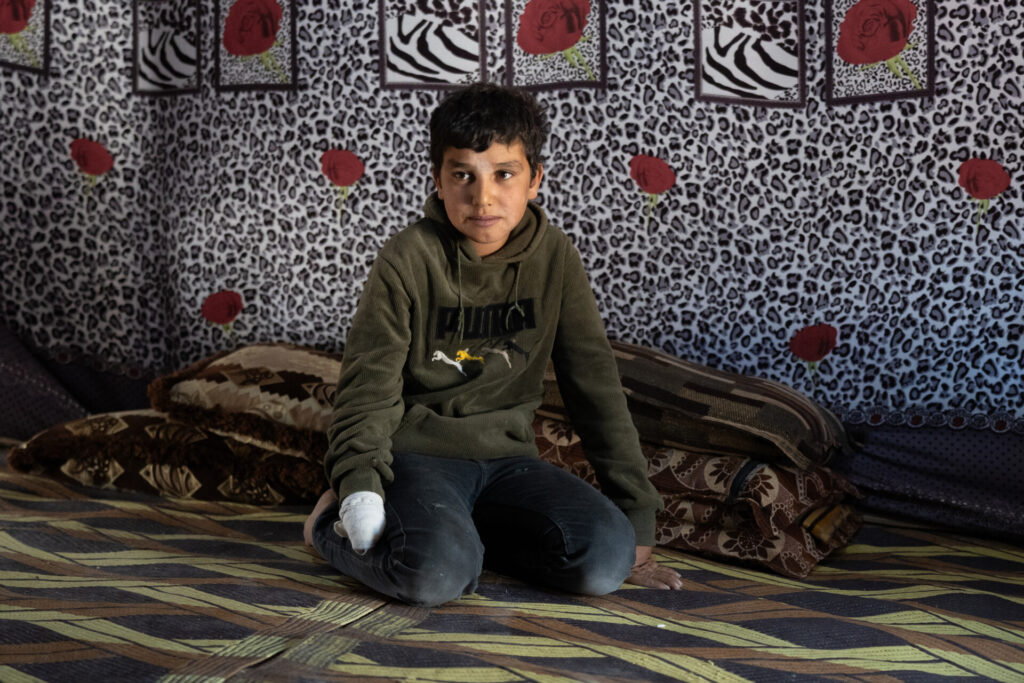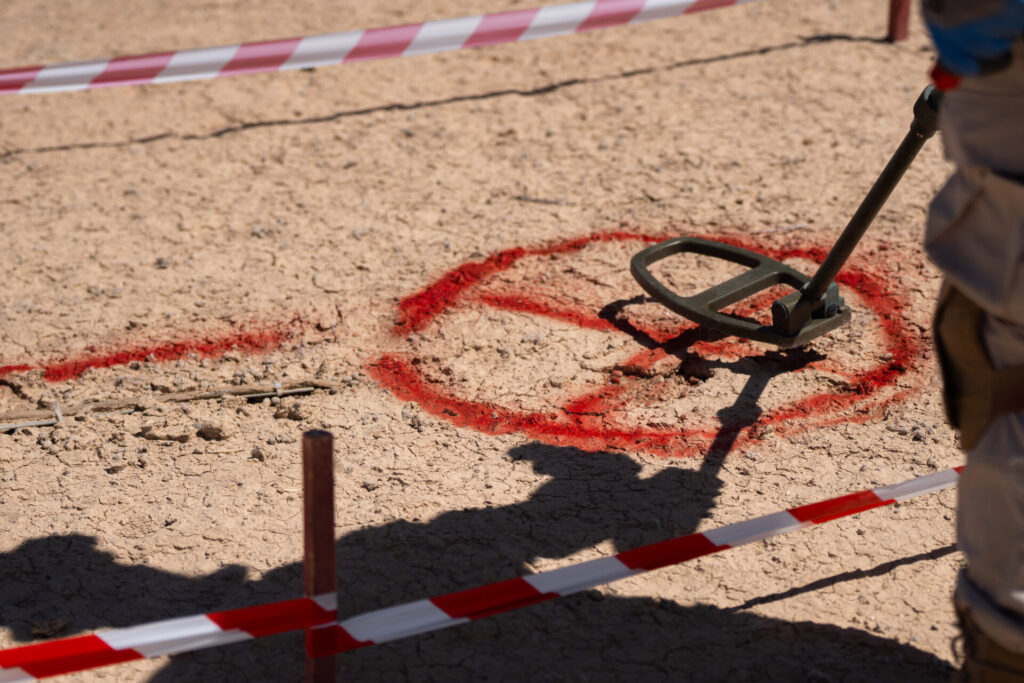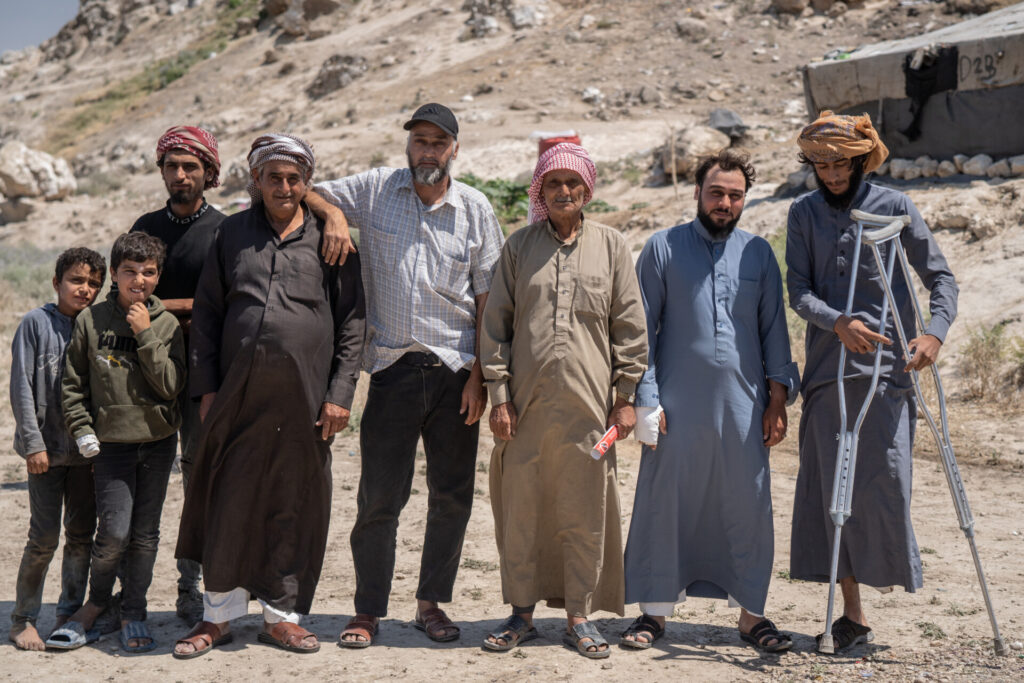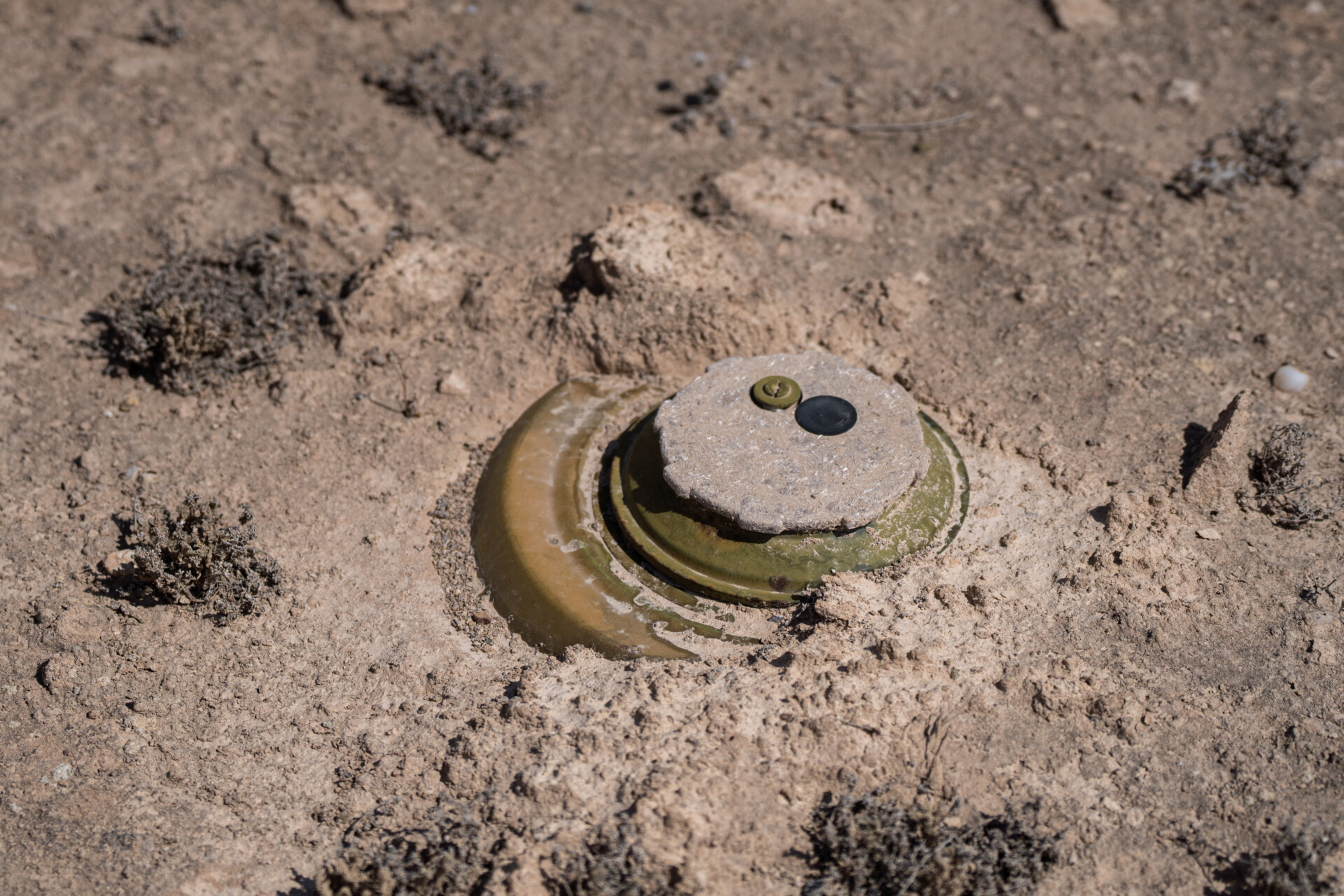Yousef Mohammed al-Ibrahim didn’t sense danger when, one day in April, he found a 23 mm shell on the outskirts of Raqqa, in northeastern Syria. Until then, it had been a quiet day for the 11-year-old boy as he peacefully grazed his grandfather’s sheep. Then he spotted it.
The projectile, a remnant from one of Syria’s many recent conflicts, looked like a curious treasure, resembling a toy in his small hands. There was more than one scattered across the ground. Containing around half an ounce of explosives, these projectiles often come from anti-aircraft cannons designed to rip through metal and can be deadly even after being fired. Yousef didn’t know that.
Pointing one of the giant bullets at the sky, Yousef urged his friend to step back before making a decision that would change his life forever. He slammed the second shell on top of the first, hoping to send it flying skyward like a firework. It exploded instantly instead, obliterating his right hand. In shock but still conscious, Yousef ran several hundred yards to his family’s makeshift camp, crying: “Mama, I lost my hand.” The family rushed him to the hospital, but the damage was already done.

Syria may be the worst place on earth right now for casualties from unexploded bombs and landmines, according to nongovernmental organizations operating in the area. According to the Landmine and Cluster Munition Monitor, explosive contamination is now “critical” across the country, and the situation is getting worse. Mines Advisory Group (MAG) Chief Executive Officer Darren Cormack calls it a “humanitarian emergency.”
On Dec. 8, 2024, celebrations erupted across Syria as the nation witnessed the stunning fall of the Baath regime and the end of Bashar al-Assad’s brutal dictatorship. Uncertainty remained about what would follow for the fragmented nation under the new interim Syrian president, Ahmad al-Sharaa, but many hoped it could beckon a new era — one of peace.
News of the United States and European Union lifting sanctions added to the hope of normalizing life in the country. In the first few months of 2025, more than a million internally displaced Syrians and a further 400,000 internationally displaced people have reportedly returned to their homes, some of which were severely damaged in the country’s civil war.
But more than 14 years of fighting have left the country full of scars: Buildings bear grim reminders of explosions and gunshots, while civilians carry the mental and physical burden of conflict and loss. Today, as Syrians slowly look toward rebuilding their lives, seven months after the fighting ended, recovery efforts are being hampered by the deadly munitions embedded in Syrian land, roads and homes.
These include countless shells that failed to detonate during years of bitter conflict between Assad’s forces, their allies and rebel factions; antipersonnel and anti-tank landmines left by government forces along shifting front lines; and improvised explosive devices (IEDs) deliberately planted to cause maximum destruction. Syria’s history of chemical weapons also raises the stakes even further, with remnants of weapons like white phosphorus posing a deadly risk to the civilian population. From the eastern governorate of Hasakah to the southern regions surrounding the capital Damascus, hospitals across Syria are now recording an alarming increase in victims suffering injuries from explosives.
Yousef only spent two hours in the hospital when he lost his hand in April. Now, several months after his life-changing accident, he sits among the same darkened tents he ran to in the encampment of Kasrat Sheikh al-Jumaa. A small white bandage replaced his right hand after the catastrophic accident. “Everything is hard now,” Yousef’s parents said, as the youngster struggled to cast a smile while sitting by their side.
Originally from Aleppo, his family fled to Raqqa in 2017 in search of safety, only to discover, like many displaced Syrians, that the land surrounding them was more dangerous than ever. “It destroyed me seeing my son lose his hand,” said Yousef’s mother, Amina Hamdo Ezz Eldien.
Her son can no longer do simple tasks independently, like washing his face. His parents are desperate to get him a new prosthetic hand to help him regain his independence, but even that has been challenging. With few options to earn a living, they now collect and sell plastic and metal scrap, putting them at even more risk of encountering further munitions hidden among the waste.
The International Committee of the Red Cross says that explosive remnants have caused at least 748 casualties in Syria since December 2024. However, organizations fear this number might be considerably higher, given the lack of definitive data on Syria’s unexploded ordnance (UXO) crisis. Mohammed Hussein al-Othman, the head of general nursing at Idlib Surgical Hospital, told New Lines he had received 350 patients injured by UXO, including 55 children and 80 women, since December 2024 at their facility alone.

Will Edmond, the head of mission at Doctors Without Borders in Syria, said a single emergency room in Deir ez-Zor hospital received at least one UXO patient per day, and 45% of the cases the group has documented since it began working there were children. “As more people begin to return, we will certainly see more of these incidents,” he warned.
“We, as Syrians, are all concerned about this matter, especially since mines, coupled with a lack of awareness, are deadly,” al-Othman added, explaining that the most common injury among these patients is the loss of limbs. But just like Yousef’s family, many Syrians have little choice but to press ahead with trying to rebuild their lives, even if they don’t know whether their next step could kill them.
All sides involved in Syria’s complex history have contributed to the country’s contamination with explosives, including government and opposition forces, militant groups and foreign actors. But they’ve left different legacies. In northeast Syria, the dramatic 2017 withdrawal of the Islamic State group from Raqqa, the capital of the group’s self-declared caliphate, left behind countless IEDs. The Islamic State planted the improvised devices along major travel routes to deter the advances of the U.S.-backed coalition and the Syrian Democratic Forces (SDF), as well as booby-trapping homes to terrorize the civilian community even further. Often made from household items, IEDs are easily overlooked by civilians unaware of what to look for. Eight years after coalition forces helped liberate the region, civilians and demining teams continue to unearth IEDs in the surrounding farmland.
Syrian government and Russian forces backing the Assad regime also used cluster munitions in densely populated areas throughout the civil war. These contain hundreds of subcluster munitions, of which it’s estimated that up to 40% fail to detonate, sitting dormant for years amid the rubble of homes and on farmland before a slight touch prompts their detonation. Syria’s legacy minefields, containing deadly anti-tank and antipersonnel mines left by the Assad regime, add another layer of danger. The vast and densely packed minefields are particularly prominent in regions that previously divided Assad’s forces from SDF-controlled territory to the northeast. Farmers working along this former front line recently alerted MAG to one such site, with deminers discovering that it is at least 3.7 miles long and 43 yards wide — and may contain hundreds of thousands of landmines, many of which need to be painstakingly diffused by hand.
Several global treaties were established against the weapons now being found in Syria. The 1997 Ottawa Treaty, signed by 165 countries so far, outlined an end to the use, stockpiling and creation of antipersonnel mines because of their impact on civilians, especially children. The 2008 Convention on Cluster Munitions (CCM) had a similar goal, banning cluster munitions because of their deadly and indiscriminate toll, which sometimes lasts for years after a conflict ends. Though Syria and foreign countries involved in its conflict, like the U.S. and Russia, are bound by the Geneva Conventions and international humanitarian law, none of them are signatories to the Ottawa Treaty and the CCM.
Haji al-Ahmad, 21, suspects it was a landmine from the Assad regime that took his foot, but he can’t be sure. Living near Yousef’s family in Kasrat Sheikh al-Jumaa, he now relies on crutches after stepping on a mine not long after Yousef’s accident. A long blue dishdasha conceals a bandaged stump where his left foot once was. “I didn’t know that there was a mine … I stepped on it and it exploded,” he said. A woman from the nearby village used her headscarf to fashion a makeshift tourniquet before taking him to the hospital. After three days there, al-Ahmad returned home, where he began to adjust to life with crutches. He never again saw the villager who saved his life, but he maintains, “God sent me this woman.”
“I won’t be able to work properly after this,” al-Ahmad said, as he rested his amputated leg on pillows to alleviate the aching pain. He was formerly a carpenter and rubbish collector, but both roles now feel impossible. As he slowly came to terms with his new reality, he also became a father for the first time. He still hasn’t thought about how he will support his wife and 2-month-old baby boy.
This is where international organizations are stepping in. A lot of Syria’s mine clearance hinges on the efforts of a handful of such organizations, like MAG, which has been operating in the region since 2016 and is the only demining group working in northeast Syria. The U.K.-based group employs 226 Syrian deminers in its 240-strong team, hailing from all walks of life — from former school teachers to engineers. MAG says it has helped clear nearly 59 million square yards of land in Syria, which the community has since used for agriculture, access to natural resources, and residential and community services, including a school previously contaminated with Islamic State IEDs in Hasakah, which 700 local students now attend.

While the direct threat facing Syrians from UXO demands the most urgent attention, the contamination also has more indirect effects. Ahmed Mohammad al-Raji, 43, owns a vast 100-acre plot of land in the Raqqa governorate, where he used to farm wheat. Located close to a former military airport, the farmland was the site of intense fighting between Syrian forces and the Islamic State until 2017, leaving the land scattered with cluster munitions and projectiles. “I was very scared,” al-Raji explained. After hearing stories of neighbors injured by explosives, he worried about his children’s safety as well as how he would provide for his family. Unable to plant and harvest crops amid the contamination, he and the 13 families that relied on the land lost their livelihoods and, to this day, have been unable to completely return. “We hated the area,” he explained, “there is no future if the contamination is still there.”
In November 2023, MAG also began the painstaking work of clearing al-Raji’s farmland so farming activities could resume. Since then, the group says it has removed 169 cluster munitions and 78 items of UXO that could have killed the farmer, his children and grazing livestock if they hadn’t been removed. With Syria reporting an estimated 75% crop failure this year due to a devastating drought in the northeast and a shortage of 2.7 million tons of wheat, clearing contaminated fields isn’t just about supporting the local farmers, but also about helping sustain a broader Syrian population, which is increasing in size as more people return.
Due to Syria’s sweltering conditions and unpredictable desert winds, working as a deminer can be tough. Yet there’s a sense of camaraderie among MAG’s teams as they head to an operations base on the outskirts of Raqqa to gather metal detectors, protective clothing and markers to cordon off dangerous areas from the public. They then embark on a drive — usually made longer by the UXO along the way — into rural Syria, where the teams face unpredictable elements while swinging metal detectors back and forth across the land to unearth the deadly remnants below. A key figure in this team is 45-year-old technical field manager Mofida Majthoub, one of only three deminers in Syria trained to skillfully and safely defuse the explosives once they’ve been found. Originally from Lebanon, Majthoub spent several years working with explosives in her home country for MAG before transferring her skills to Syria to help tackle its landmine crisis. On any given day in the field, she’ll help oversee the demining teams while also being responsible for leaning over an explosive, carefully removing the dangerous detonators and defusing the device.
One recent clearance included an IED thought to have been left by the Islamic State, buried at a barren site that several remote farming families must travel through to access a weekly market. A local farmer had alerted the deminers to a suspected explosive, only for demining teams to discover several more nearby. The metal pot contained over 20 pounds of explosives neatly packed and buried beneath the sand. Attached to the explosive device was a strip, roughly 3 feet long, that would trigger a massive and deadly explosion when driven over or stepped on. As she’s done countless times before, Majthoub masterfully disarmed the device within several minutes as her all-male team watched from a safe perimeter.

“It’s in good shape,” Majthoub told New Lines after she inspected the IED. As she suspected, hidden beneath the explosive was a second detonator, which she had to carefully dislodge before lifting the explosive out of the ground. Majthoub was also particularly pleased with this one: In the coming days, she would effectively recycle the explosives, using them to fuel a controlled demolition to safely blow up other old munitions that MAG had been stockpiling from previous clearance missions.
“It’s not about the number of items I’m removing, it’s about the people and the lives we are saving,” Majthoub said when describing how she feels about her work. “It’s about sustainable development for the economy itself, where the people, especially the displaced people, will be able to return home to build their residence, to use their lands, whether to build houses or to plant it or for grazing or even for any industrial use,” she added. “We have to be sure about what we are doing, to do it properly. We cannot let fear come in.”
Alongside contamination, the biggest challenge facing Syria is a lack of awareness about the dangers that explosives pose, particularly among children, like Yousef, who may even play with the devices. “Some people have lived with explosives for too long,” said Fatima Abdi, MAG’s community liaison manager, suggesting that indifference can also be deadly. Abdi recalled how a Syrian woman in Deir ez-Zor had planted a circle of flowers around an object in her garden, unaware of the symbolic contrast between the colorful plants and the unexploded bomb in the middle. Another resident had hung a collection of Russian-made explosives close to her home as “decoration.” MAG relies on 10 Arabic- and Kurdish-speaking teams to run potentially lifesaving community awareness sessions across northeast Syria, where residents learn to identify dangers to avoid and how to report sightings of explosives.
It’s also a symbiotic relationship: Any documents about the location of Syria’s deadly minefields are thought to have long been destroyed, so the local communities play a vital role in sharing information with MAG about where possible UXO is buried.
“From the experience, I’ve come to realize that young boys actually give more information than the adults,” Abdi said, adding that curious children, who usually spend more time playing in the fields, have helped report dangerous explosives to MAG teams over the last few months, potentially saving lives.
MAG’s community liaison efforts are also adding details to the record of Syria’s brutal war. “We collect information not only about the contamination but also why this contamination is in the community,” Abdi continued. “Why was the land mined because of the war? We record all this information, and we also look at the threats of the contamination to the community, and we put it in our data.” Despite increasing UXO and landmine clearance efforts by groups like MAG, the sheer volume of explosives being discovered in Syria suggests there’s a long road ahead.
International funding also remains a fraction of what is needed to confront Syria’s crisis: MAG estimates that at least $25 million in annual funding is required to continue meaningful efforts across Syria, yet many Western countries have taken dramatic steps in reducing their overseas aid contributions to boost their own military budgets instead.
Even the hospitals treating UXO patients face challenges: MSF’s team said three unexploded munitions were found within Deir ez-Zor National Hospital, which Edmonds said “has hindered [its] ability to scale up the response.”

Political uncertainties and the seemingly fragile governance of Syria are also delaying progress. The country is effectively split in two for now: The northeast is controlled by the Kurdish-backed SDF, while the rest of the country is under the control of the new central government. Gaining permission to operate across both territories remains an obstacle for demining teams hoping to tackle new contaminated areas. Majthoub explained that the division between the two areas had made MAG’s work harder.
Yet combining education sessions with landmine and UXO clearance can make a difference, particularly among communities bearing the brunt of contamination. In another tent in Yousef’s village, 11 men, women and children had gathered in front of a board displaying various images related to landmines and UXO. The lecture, presented in Arabic, explained what to do, what not to touch and how to report any cases of explosives. The audience looked deeply invested, knowing all too well that the session could save someone’s life.
At one point, Yousef also came and sat at the edge of the lecture with his friend, knowing more than some exactly what’s at stake.
“Spotlight” is a newsletter about underreported cultural trends and news from around the world, emailed to subscribers twice a week. Sign up here.



